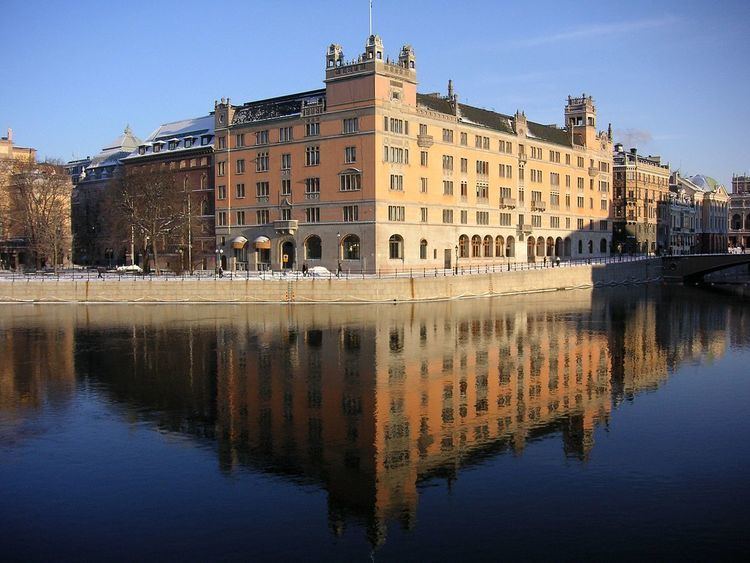Role Executive cabinet Members Löfven Cabinet | Established 1975 Prime Minister Stefan Löfven | |
 | ||
Predecessor entities Privy Council(12th century—1809)Council of State(1809—1974) | ||
The Government of the Kingdom of Sweden (Swedish: Konungariket Sveriges regering) is the national cabinet and the supreme executive authority in Sweden. The short-form name Regeringen ("the Government") is used both in the Fundamental Laws of the Realm and in the vernacular, while the long-form is only used in international treaties.
Contents
- Map of Sweden
- Role and scope
- High Contracting Party
- Promulgation
- Formation and dismissal
- Former cabinets
- Government offices
- List of Government ministries and offices
- References
Map of Sweden
The Government operates as a collegial body with collective responsibility and consists of the Prime Minister—appointed and dismissed by the Speaker of the Riksdag (following an actual vote in the Riksdag before an appointment can be made)—and other cabinet ministers (Swedish: Statsråd), appointed and dismissed at the sole discretion of the Prime Minister. The Government is responsible for its actions to the Riksdag.
Following the adoption of the 1974 Instrument of Government on 1 January 1975—the Government in its present constitutional form was constituted—and in consequence thereof the Swedish Monarch is no longer vested any nominal executive powers at all with respect to the governance of the Realm, but continues to serve as a strictly ceremonial head of state.
Role and scope
Instrument of Government, Chapter 12, Article 1.
The Instrument of Government (Swedish: Regeringsformen)—one of the Fundamental Laws of the Realm—sets out the main responsibilities and duties of the Government (including the Prime Minister and other cabinet ministers) and how it relates to other organs of the State.
Instrument of Government, Chapter 12, Article 1.
Most state administrative authorities (Swedish: statliga förvaltningsmyndigheter), as opposed to local authorities (Swedish: kommuner), sorts under the Government, including the Armed Forces, Coast Guard, Customs Service and the Swedish police.
While the Judiciary technically sort under the Government in the fiscal sense, Chapter 11 of the Instrument of Government provides safeguards to ensure its independence.
In a unique feature of the Swedish constitutional system, individual cabinet ministers do not bear any individual ministerial responsibility for the performance of the agencies within their portfolio; as the director-generals and other heads of government agencies reports directly to the Government as a whole; and individual ministers are prohibited to interfere (thus the origin of the pejorative (in Swedish political parlance) term ministerstyre (English: "ministerial rule") in matters that are to be handled by the individual agencies, unless otherwise specifically provided for in law.
High Contracting Party
The Government of Sweden is the high contracting party when entering treaties with foreign sovereign states and international organisations (such as the European Union), as per 10:1 of the Instrument of Government. In most other parliamentary systems (monarchies and republics alike) this formal function is usually vested in the head of state but exercised by ministers in such name.
Promulgation
Chapter 6, Article 7 prescribes that laws and ordinances are promulgated by the Government (by the Prime Minister or other cabinet minister), and are subsequently published in the Swedish Code of Statutes (Swedish: Svensk författningssamling).
Formation and dismissal
Following a general election, Speaker of the Riksdag begins to hold talks with the leaders of the parties with representation in the Riksdag, the Speaker then nominates a candidate for Prime Minister (Swedish: Statsminister). The nomination is then put to a vote in the chamber. Unless an absolute majority of the members (175 members) votes "no", the nomination is confirmed, otherwise it is rejected. The Speaker must then find a new nominee. This means the Riksdag can consent to a Prime Minister without casting any "yes" votes.
After being elected the Prime Minister appoints the cabinet ministers and announces them to the Riksdag. The new Government takes office at a special council held at the Royal Palace before the Monarch, at which the Speaker of the Riksdag formally announces to the Monarch that the Riksdag has elected a new Prime Minister and that the Prime Minister has chosen his cabinet ministers.
The Riksdag can cast a vote of no confidence against any single cabinet minister (Swedish: Statsråd), thus forcing a resignation. To succeed a vote of no confidence must be supported by an absolute majority (175 members) or it has failed.
If a vote of no confidence is cast against the Prime Minister this means the entire government is rejected. A losing government has one week to call for a general election or else the procedure of nominating a new Prime Minister starts anew.
Former cabinets
Each appointment of a new Prime Minister is considered to result in a new cabinet, irrespective if the Prime Minister is reappointed or not. However, there is no automatic resignation following a defeat in a general election, so an election does not always result in a new cabinet.
Government offices
Previously known as the Royal Chancery (Swedish: Kunglig Majestäts kansli), the name was changed to the Government Offices (Swedish: Regeringskansliet) on 1 January 1975 with the current Instrument of Government entering into effect.
The Instrument of Government briefly mentions in Chapter 7, Article 1 that there is a staff organization supporting the Government known as the Government Offices. The present organizational charter for the Government Offices is found in the ordinance named Förordning (1996:1515) med instruktion för Regeringskansliet. Since the issuance of the beforementiond ordinance in 1996, all the ministries are entities within the Government Offices (headed by the Prime Minister), rather than as separate organisations. Below follows a short summary of the current structure.
List of Government ministries and offices
Only current ministries and offices are listed below:
